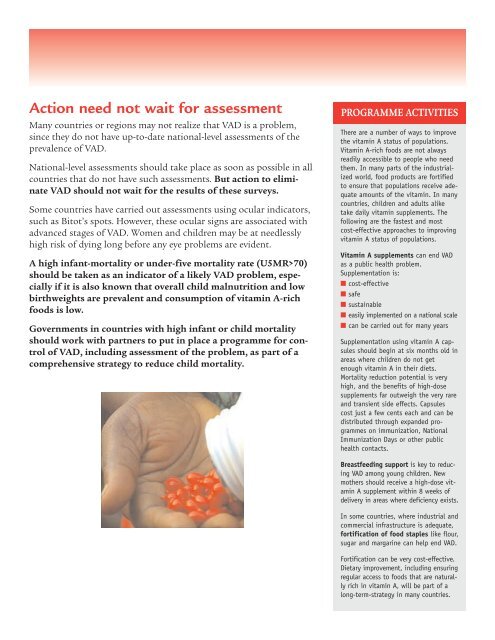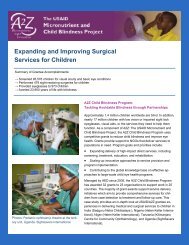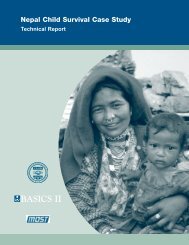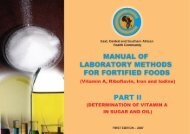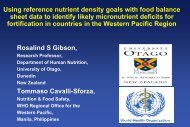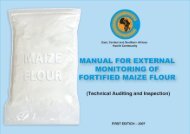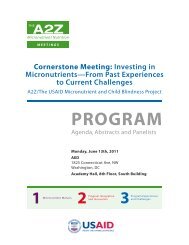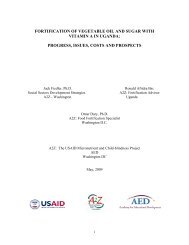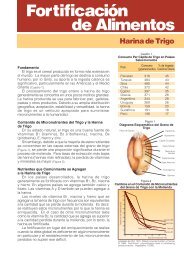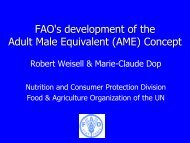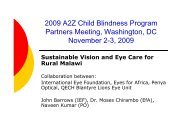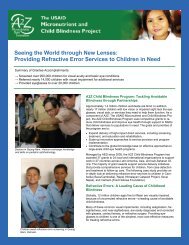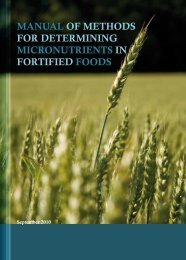Vitamin A Global Initiative - A2Z: The USAID Micronutrient and Child ...
Vitamin A Global Initiative - A2Z: The USAID Micronutrient and Child ...
Vitamin A Global Initiative - A2Z: The USAID Micronutrient and Child ...
You also want an ePaper? Increase the reach of your titles
YUMPU automatically turns print PDFs into web optimized ePapers that Google loves.
Action need not wait for assessment<br />
Many countries or regions may not realize that VAD is a problem,<br />
since they do not have up-to-date national-level assessments of the<br />
prevalence of VAD.<br />
National-level assessments should take place as soon as possible in all<br />
countries that do not have such assessments. But action to eliminate<br />
VAD should not wait for the results of these surveys.<br />
Some countries have carried out assessments using ocular indicators,<br />
such as Bitot’s spots. However, these ocular signs are associated with<br />
advanced stages of VAD. Women <strong>and</strong> children may be at needlessly<br />
high risk of dying long before any eye problems are evident.<br />
A high infant-mortality or under-five mortality rate (U5MR>70)<br />
should be taken as an indicator of a likely VAD problem, especially<br />
if it is also known that overall child malnutrition <strong>and</strong> low<br />
birthweights are prevalent <strong>and</strong> consumption of vitamin A-rich<br />
foods is low.<br />
Governments in countries with high infant or child mortality<br />
should work with partners to put in place a programme for control<br />
of VAD, including assessment of the problem, as part of a<br />
comprehensive strategy to reduce child mortality.<br />
PROGRAMME ACTIVITIES<br />
<strong>The</strong>re are a number of ways to improve<br />
the vitamin A status of populations.<br />
<strong>Vitamin</strong> A-rich foods are not always<br />
readily accessible to people who need<br />
them. In many parts of the industrialized<br />
world, food products are fortified<br />
to ensure that populations receive adequate<br />
amounts of the vitamin. In many<br />
countries, children <strong>and</strong> adults alike<br />
take daily vitamin supplements. <strong>The</strong><br />
following are the fastest <strong>and</strong> most<br />
cost-effective approaches to improving<br />
vitamin A status of populations.<br />
<strong>Vitamin</strong> A supplements can end VAD<br />
as a public health problem.<br />
Supplementation is:<br />
■ cost-effective<br />
■ safe<br />
■ sustainable<br />
■ easily implemented on a national scale<br />
■ can be carried out for many years<br />
Supplementation using vitamin A capsules<br />
should begin at six months old in<br />
areas where children do not get<br />
enough vitamin A in their diets.<br />
Mortality reduction potential is very<br />
high, <strong>and</strong> the benefits of high-dose<br />
supplements far outweigh the very rare<br />
<strong>and</strong> transient side effects. Capsules<br />
cost just a few cents each <strong>and</strong> can be<br />
distributed through exp<strong>and</strong>ed programmes<br />
on immunization, National<br />
Immunization Days or other public<br />
health contacts.<br />
Breastfeeding support is key to reducing<br />
VAD among young children. New<br />
mothers should receive a high-dose vitamin<br />
A supplement within 8 weeks of<br />
delivery in areas where deficiency exists.<br />
In some countries, where industrial <strong>and</strong><br />
commercial infrastructure is adequate,<br />
fortification of food staples like flour,<br />
sugar <strong>and</strong> margarine can help end VAD.<br />
Fortification can be very cost-effective.<br />
Dietary improvement, including ensuring<br />
regular access to foods that are naturally<br />
rich in vitamin A, will be part of a<br />
long-term-strategy in many countries.


